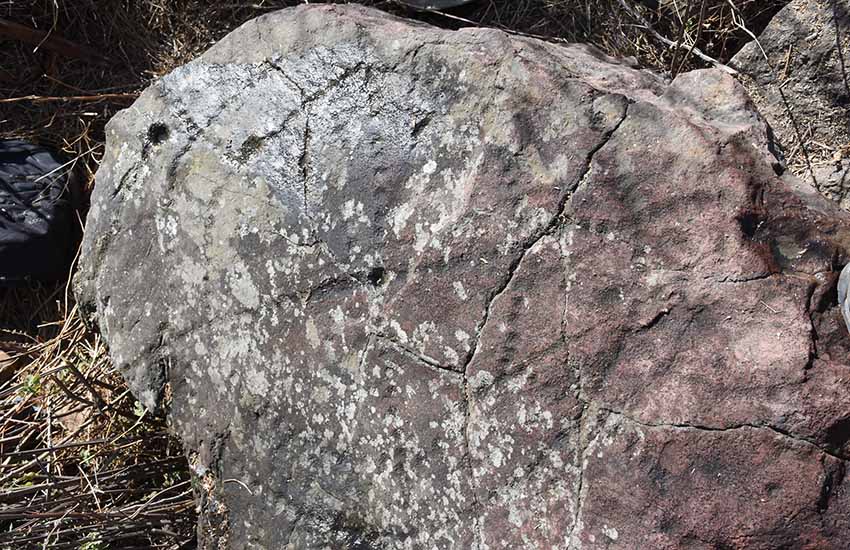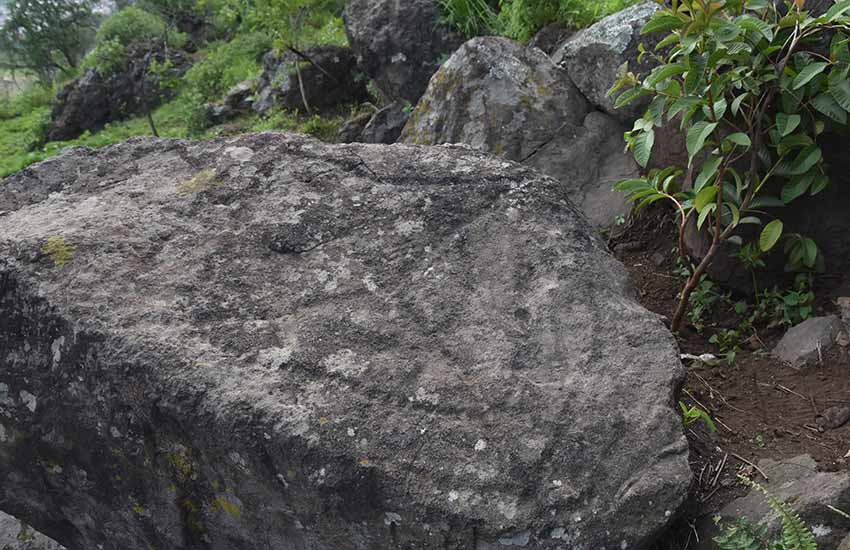Javier Márquez Juárez and I have walked the unexcavated ruins above San Gregorio Atlapulco dozens of times. We’ve walked for as long as four hours, always coming across more ruins — remains of buildings, temazcales (akin to sweat lodges), altars. Márquez has worked alongside several archaeologists, researched and written about the ruins and has become something of an expert on them.
According to Eric Saloma García, one of the archaeologists who has studied and written about these ruins, the site was occupied by different indigenous groups over a couple of millennia. He believes the oldest ruins to be 2,000 years old, and the most recent approximately 600 years.
Other, earlier groups almost certainly lived there but, as far as we can tell, left no trace.
At one entrance to the ruins stand two huge boulders with carvings. One depicts either a priest of Xipe Totec, the Aztec god of agriculture and sacrifice, or Xipe Totec himself. The other is a carving of Cihuateteo, the Aztec fertility goddess.
The presence of these two carvings and the large number of temazcales has led Márquez and others to posit that the ruins are probably the remains of a sacred city.

During our explorations, Márquez and I have also come across a multitude of stones carved with what could have been maps, showing water sources, figures of gods, spirals and crosses. Sometimes it seems like every stone we pass has a story to tell.
Among the most interesting are three large stones, each carved with what’s called a cruz punteada, also known as a pecked cross.
“At the end of the 1970s, archaeologists studying Teotihuacán found in floors and rocks geometric patterns formed by a series of [holes] drawn as two concentric circles and divided into four parts by a cross,” he said. The ancient city of Teotihuacán is located about 25 miles from Mexico City.
The circles and the interior cross were formed by drilling, or “pecking” holes into rocks. These cruces punteadas have been found on sites from northern Mexico down to Guatemala. Although the most common of them are those Márquez described, there are a number of variations.
Some crosses have been found that have three circles instead of two, one that’s been found is shaped like a Maltese Cross and some feature rectangles instead of circles. One common element in all of the crosses is their division into four quadrants, something that represents indigenous cosmological beliefs.
Despite being studied for decades, the exact meaning of the crosses still remains something of a mystery.
The majority of archaeologists agree that some must have been used as astronomical devices, although those found carved into floors inside buildings or on rocks in caves can’t have been used as such. Other possible uses include calendars, urban planning devices or a tool that priests employed in some way to make predictions.
They may have been used in different ways by different cultures.
Márquez was alone when he found the first cruz punteada we’ve documented. Finding it took some luck — first bad and then good. He was wandering among the ruins when he came upon an area filled with large rocks. “When I jumped from one to another, I slipped and fell,” he related. He injured his left leg. “The pain was intense, and I crawled to another large stone and sat.”
He laid the bag he was carrying and his machete on the stone and checked to see the damage to his leg; fortunately, he didn’t break anything. When the pain subsided, he turned to pick up his bag and machete.
“I saw that this stone had many small holes. I ran my hands over the stone and realized … they made two circles and a cross. I realized it was a Teotihuacanan cruz punteada.”
Márquez and I have returned to that cruz punteada many times, and he’s sometimes returned on his own, trying to tease out its significance. This specimen has the double circle and a central cross whose arms extend beyond the outer circle.

“With this particular cruz punteada, we can see that it aligns with important hills in the Valley of México,” he remarked.
There are 265 holes in this cross, and three of them are larger than the rest. One is on the left and outside the double circles, one is in the center of the cross and the third is on the extreme right, outside the double circles.
“If we align the [hole] on the left with the central [hole], we directly observe the hill called Xochitepec,” Márquez said. “In this hill is a ceremonial center where on December 21, the winter solstice, the sun can be observed rising directly above the crater of Popocatépetl [a volcano located in the states of México, Puebla and Morelos].”
Drawing a line through the other two holes points to Pico del Águila, a hill revered by pre-Hispanic groups. Márquez has also postulated that these crosses may be connected in some way with Venus, an important planet in Mesoamerican cosmology.
A second cruz punteada found here by archaeologist Roberto Palacio has the two concentric circles and a central cross like the one described above but is carved into a smaller rock. Like the other example, it appears that the arms of the cross extend beyond the outer circle.
A third cruz punteada was found only recently and is markedly different from the other two. That one has a central cross with a small inner circle that’s surrounded by two squares. The significance of these differences is unknown, and both require further study to determine if they align with other important pre-Hispanic ceremonial sites or hills.
Most archaeologists view the presence of a cruz punteada as proof of Teotihuacán’s influence throughout Mesoamerica. But Márquez has come to believe that, for the ruins in San Gregorio, there was more than just influence and that before Teotihuacán was a sacred city built by the Mexicas (Aztecs), Teotihuacanos may have settled in the hills around San Gregorio.
He points to the fact that, in addition to three cruces punteadas, there’s a small pyramid that was constructed in the San Gregorio ruins, using techniques found in Teotihuacán. Some vessels similar to those found in Teotihuacán have also been discovered.
“These are indications that in the territory that is now San Gregorio there was a Teotihuacano settlement. This was between 100 and 800 years after Christ,” said Márquez. “I think there was an astronomical center … a Teotihucano astronomical observatory … here before the Xochimilcas or Mexicas (two indigenous groups) arrived,” he said.
Márquez continues to regularly visit the ruins, searching for further proof of a Teotihuacano settlement.
Joseph Sorrentino, a writer, photographer and author of the book San Gregorio Atlapulco: Cosmvisiones and of Stinky Island Tales: Some Stories from an Italian-American Childhood, is a regular contributor to Mexico News Daily. More examples of his photographs and links to other articles may be found at www.sorrentinophotography.com He currently lives in Chipilo, Puebla.
